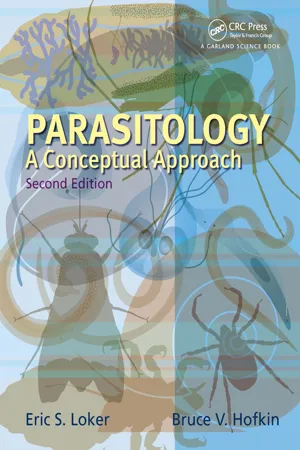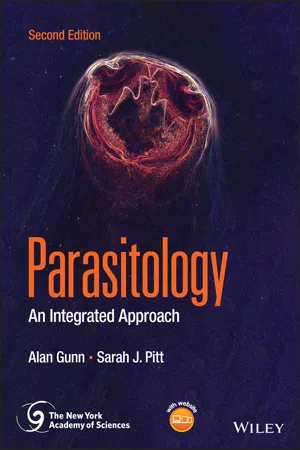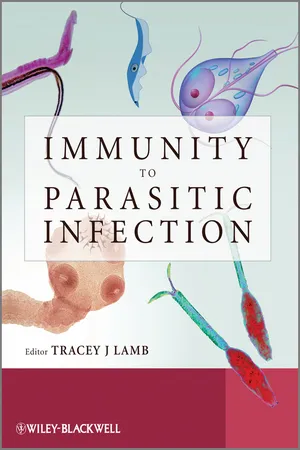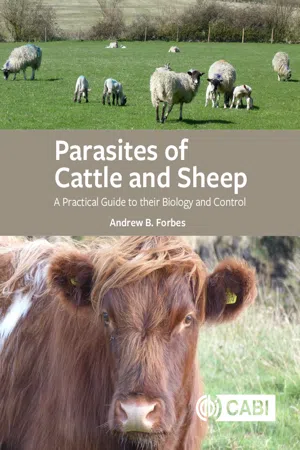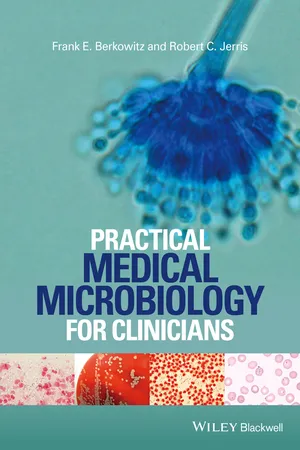Biological Sciences
Tapeworm Life cycle
The tapeworm life cycle involves multiple stages. It begins with eggs being passed in the feces of the host. These eggs are then ingested by an intermediate host, such as a flea or a small animal, where they develop into larvae. When the intermediate host is consumed by the primary host, the tapeworm larvae mature into adult tapeworms in the primary host's intestines.
Written by Perlego with AI-assistance
Related key terms
Related key terms
1 of 4
Related key terms
1 of 3
8 Key excerpts on "Tapeworm Life cycle"
- eBook - ePub
Parasitology
A Conceptual Approach
- Eric S. Loker, Bruce V. Hofkin(Authors)
- 2022(Publication Date)
- CRC Press(Publisher)
The life cycle can be defined as the sequence of developmental events that occurs over the course of an organism’s lifetime. For parasites, at least some of these events occur in or on the host. Many parasites require different hosts for different developmental events. In such cases, these hosts are colonized in a specific sequence. As we will see, given the way parasite life cycles are usually depicted, completion of the life cycle might involve progeny of the initiating parasite and involvement of another individual as a mate. Early medical and natural history studies gave rise to an understanding of parasite life cycles Because they are relatively large, certain helminths were the earliest infectious agents recognized in humans and animals (Figure 3.1). Ancient Egyptian medical chronicles, including the Ebers papyrus dated at about 1500 BC, describe nematodes, possibly Ascaris and the hookworm Ancylostoma duodenale, that commonly infected humans. Around 400 BC, Hippocrates described seed-like structures in human feces that were most likely tapeworm reproductive segments. In one of the earliest discussions of habitat site selection in the host, in approximately 180 AD, the Greek physician Galen described nematodes in the human intestine that inhabited the distal end of the colon near the anus (probably pinworms). Other larger worms preferred the upper portion of the small intestine (probably Ascaris). Figure 3.1 A historical reference to Dracunculus medinensis, the Guinea worm. Asclepius, the Greek god of medicine and healing, holds his staff (the staff of Asclepius). The snake-entwined staff is believed to come from the age-old practice of guinea worm removal, in which the long female worm is slowly wrapped on a stick. The staff of Asclepius (or sometimes the staff of Caduceus, entwined with two snakes) has come to symbolize modern medicine - eBook - ePub
Parasitology
An Integrated Approach
- Alan Gunn, Sarah J. Pitt(Authors)
- 2022(Publication Date)
- Wiley(Publisher)
The adult worms live within the small intestine and vary in size from species such as T. saginata that grows up to 20 m in length to Echinococcus multilocularis that is typically only 1.2–3.7 mm long. The adult tapeworms reproduce sexually, and their eggs are passed with the host’s faeces. Subsequently, the eggs are consumed by the intermediate host through faecal–oral contamination. The eggs then hatch within the small intestine of the intermediate host to release an oncosphere that penetrates the gut and is swept in the circulation to a point in the body where it develops into the metacestode (larval) stage. In some taeniid species, the metacestode exhibits asexual reproduction. The extent to which asexual reproduction takes place is related to the size of the adult worm. Those species that produce large adult tapeworms, such as T. saginata and T. solium, do not reproduce asexually during the metacestode stage. By contrast, medium‐sized species, such as T. multiceps (0.4–1 m) may exhibit some asexual reproductive capacity during the metacestode stage, whilst species that have very small adults such as E. granulosus undergo extensive asexual reproduction (Moore and Brooks 1987). Completion of the life cycle occurs when the definitive host consumes the metacestode stage. In the past, it was often uncertain which larval stage was related to which adult worm. Consequently, larval stages sometimes acquired names that are quite different from those of the adult worm. For example, the larval stage of Taenia hydatigena was known as Cysticercus tenuicollis, that of Taenia solium was known as Cysticercus cellulosae, whilst that of T. multiceps was called Coenurus cerebralis. Unfortunately, some workers continue to use these older names when referring to the larval stages. Consequently, one must be aware of the different names when reading and searching the literature. Figure 5.16 Taenia solium life cycle stages. (a) Adult stage, scolex - eBook - ePub
- Tracey Lamb, Tracey Lamb(Authors)
- 2012(Publication Date)
- Wiley-Blackwell(Publisher)
Memorias do Instituto Oswaldo Cruz 105(4), 422–435.Ross, AG et al . (2007). Katayama syndrome. The Lancet Infectious Diseases 7(3), 218–224.Wynn, TA et al . (2004). Immunopathogenesis of schistosomiasis. Immunological Reviews 201, 156–167.Passage contains an image 17 Cestoda: Tapeworm Infection César A. Terrazas, Miriam Rodríguez-Sosa and Luis I. Terrazas Unidad de Biomedicina, Universidad Nacional Autónoma de México, México, US
Tapeworms are a very diverse group of parasites of the class Cestoda, the most characteristic tapeworms being classified in the subfamilies Taeniidae and Echinococcinae. In general, adult tapeworms infect the small intestine of carnivorous and omnivorous mammals, including humans, and they are distributed worldwide. Taenia and Echinococcus are globally of medical and veterinary interest as the causative agents of morbidity and mortality in humans, as well as production losses of livestock. Given this importance, we will focus on Taenia solium, Echinococcus granulosus and E. multilocularis as examples of tapeworms and discuss their life cycles, pathology, epidemiology, immune responses and evasive mechanisms, complemented with experimental data from laboratory models.17.1 The life cycle of tapewormsTapeworms usually need at least two hosts to complete their life cycle; an intermediate host and a definitive host where they reach maturity. Individual organisms from different species of Taenia (including T. solium and T. saginata ) are morphologically homogenous in their adult stage; they are generally flat and large, displaying a tape-like morphology often exceeding several meters in length, with a distinctly segmented strobila and a characteristic arrangement of rostellar hooks on their scolex (Figure 17.1 ). Life cycles for Taenia involve two mammalian hosts, including a carnivorous or omnivorous definitive host.T. soliumFigure 17.1 Life cycle of Taenia solium . - eBook - ePub
- D. C. Shanson(Author)
- 2014(Publication Date)
- Butterworth-Heinemann(Publisher)
Taenia solium can cause serious disease if biliary tract infection or infection of the brain (cysticercosis) occurs, respectively. Strongyloidiasis can be disseminated and fatal in a patient with an impaired immunological reaction as in an immunosuppressed patient with Hodgkin’s disease.The brief notes that follow summarize the main features of worms which may cause clinical problems in patients living in Britain or arriving from overseas. It should be remembered that simultaneous multiple infestations with different worms often occurs.CESTODES (TAPEWORMS)
Taenia saginata
The tapeworm Taenia saginata is the commonest tapeworm and the adult worm may reach up to 30 feet in length in the small intestine of humans. Asymptomatic infestation is common but minor abdominal symptoms including mild discomfort, diarrhoea or vomiting sometimes occurs. Often the passing of a wriggling mature segment through the anus into the toilet is the main complaint.Geographical distribution
Worldwide but especially in Africa and the Middle East.Life cycle
Humans, the definitive hosts of the worm, eat undercooked beef containing the cysticercus (larval stage). An adult worm develops in the person’s intestine and the sexual phase of the life cycle is completed there, ova in the faeces of humans are swallowed by the cow which is the worm’s intermediate host. The asexual multiplication phase of the life cycle is completed in the cow and the cysticercus is found in its flesh.Complications
None as a rule.Diagnosis
Examination of a mature segment (proglottid) shows numerous lateral branches of the uterus which helps to differentiate it from Taenia solium which has less uterine branches. Microscopy of a wet preparation of faeces may reveal characteristic cystic ova of Taenia - eBook - ePub
Parasites of Cattle and Sheep
A Practical Guide to their Biology and Control
- Andrew B Forbes(Author)
- 2020(Publication Date)
- CAB International(Publisher)
5 Tapeworm InfectionsIntroductionUnlike parasitic nematodes, tapeworms (cestodes) have a complex life cycle that involves a definitive/final host in which reproduction takes place and intermediate hosts in which asexual development takes place. Hence ruminants can be either definitive hosts, harbouring adult tapeworms in their intestinal tract, or they can be intermediate hosts to developmental stages of tapeworms whose definitive hosts are carnivores – mainly dogs among domestic animals. The life cycle of some of the tapeworm species listed below includes wildlife, either as definitive or intermediate hosts, and this can have ramifications into epidemiology and control (Torgerson and Budke, 2003 ;DeWolf et al., 2014). Stages of two species are potentially zoonotic: man is the definitive host of Taenia saginata and also one of several species of intermediate host that can be infected with hydatid cysts. Table 5.1 provides summary information on the cestode species commonly associated with cattle and sheep.Ruminants as Final HostsTable 5.1. Summary information on common cestodes that parasitize sheep and cattle.The most common adult tapeworms that infect cattle and sheep belong to the genus Moniezia; while they can infect a variety of final hosts, the species most commonly found in cattle and sheep are (Nguyen et al., 2012):• Moniezia expansa (sheep)• Moniezia benedeni (cattle)Host species is an unreliable criterion for identification of adult worms, and differentiation of these species is based on morphological features (Reinecke, 1983 ); molecular techniques have also been developed (Nguyen et al., 2012) and these have shown the possible existence of cryptic species within these two main types (Chilton et al., 2007). The scientific literature on Moniezia is predominantly based on studies on M. expansa - eBook - ePub
- Frank E. Berkowitz, Robert C. Jerris(Authors)
- 2015(Publication Date)
- Wiley-Blackwell(Publisher)
SECTION V ParasitologyPassage contains an image
CHAPTER 22 Parasitology
General description of parasites
The microorganisms that are, by tradition, referred to as “parasites” are eukaryotes. They are classified, for convenience, into protozoa (single-celled organisms), worms, and ectoparasites. As a general principle, protozoa multiply within the host (as do viruses and bacteria). In contrast, with a few exceptions, e.g. Strongyloides stercoralis, worms do not multiply within the host. The “worm burden” is the number of worms entering the host. The protozoa are classified into four groups: flagellates, ciliates (of which only one infects humans), amebae, and apicomplexa (sporozoa). The worms are classified into three groups: roundworms (nematodes), flukes (trematodes), and tapeworms (cestodes). From a clinical standpoint, it is also convenient to classify the internal parasites into those infecting primarily the gut (even if they pass through the blood and tissues to reach there, in the case of some worms) and those infecting primarily the blood or tissues other than the gut.Life cycle
This describes the pathway that the parasite takes from the time of entering the host, its pathway through the host, its exit and spread to another host, until its progeny reach the same point in another host. An understanding of the life cycle is essential for understanding the pathogenesis of the infection, its epidemiology, and its clinical manifestations. It thus provides the information on which methods for preventing transmission can be based. Many parasites that affect humans, in particular worms, have an animal host as part of their life cycle in the following ways.- The parasite is an animal parasite and humans are incidental hosts, e.g. Babesia, Toxocara, Echinococcus.
- An animal is one of the hosts in a cycle that normally involves humans, e.g. Schistosoma spp., in which a snail is the intermediate host.
- Nicola Lakeman (Previously Ackerman), Victoria Aspinall(Authors)
- 2016(Publication Date)
- Elsevier(Publisher)
Fig. 29.39 ). The adult tapeworm is found in the intestine attached to the intestinal wall by the scolex, which often bears hooks and suckers to assist in making a secure attachment. The segments are produced in a neck region behind the scolex and contain both male and female reproductive tracts, so a single tapeworm can reproduce without need of other tapeworms. As a segment becomes older, signified by its being pushed towards the end of the worm by the younger segments, the eggs inside it develop, until it is almost nothing more than a bag of eggs. Ultimately the attachment to the segment behind breaks down and the segment moves down the intestine with the other intestinal contents to pass through the rectum and into the environment. Segments have a primitive nervous system and are capable of some movement, so may make their own way out of the anus. In the environment the segment is broken down and the eggs are released.Fig. 29.39Cestode. (A ) Anterior end. (B ) Mature segment or proglottidAll tapeworms have an intermediate stage of development called the metacestode, the appearance of which varies with tapeworm species. Normally the metacestode is found in a host of a different species from the final host in which the adult tapeworm occurs. The final host is infected when it eats the intermediate host carrying the metacestode. For example, the flea carries the immature cysticercoid stage of Dipylidium caninum and dogs and cats are infected when they eat an infected flea. Drugs with cestocidal action are shown in Tables 29.5 –29.7 .Anoplocephala perfoliata
A. perfoliata and its relation Anoplocephala magna are two squat, stumpy tapeworms typically found around the ileocaecal junction of a horse's intestine. The intermediate host is the oribatid mite, which can occur in large numbers on pasture. Horses are infected when they ingest the mites with grass. Large numbers of tapeworms are associated with an increased incidence of colic. Control is based on the use of anthelmintics with cestocidal action.Dipylidium caninum
D. caninum is a tapeworm that occurs in dogs and cats (Fig. 29.40 ). It is delicate in appearance compared to Taenia- eBook - ePub
- Lynne Shore Garcia(Author)
- 2016(Publication Date)
- ASM Press(Publisher)
For this reason, H. nana has been considered to be the most common tapeworm throughout the world, and it is estimated that 50 million to 75 million people worldwide are infected. The infection is most commonly seen in children, although adults are also infected (Table 16.1). There has been some discussion regarding placing H. nana in the genus Rodentolepis ; however, for this edition of the book, we will continue to use Hymenolepis (Rodentolepis) nana. The presence of Rodentolepis microstoma (rodent tapeworm) in humans has been reported for the first time; the data came from a 3-year survey of gastrointestinal parasites in remote communities in the northwest of Western Australia (59). However, to date, there is little information available regarding other human infections with this parasite. Life Cycle and Morphology The life cycle can be seen in Fig. 16.27. Infection is usually acquired by the ingestion of infective H. nana eggs, primarily from human stool (direct life cycle). The eggs hatch in the stomach or small intestine, and the liberated larvae, or oncospheres, penetrate the villi in the upper small intestine. The larvae develop into the cysticercoid stage in the tissue and migrate back into the lumen of the small intestine, where they attach to the mucosa (Fig. 16.28). The adult worms mature within several weeks. They are very small compared with worms of the Taenia species and measure up to 40 mm long. The more worms that are present, the shorter the total length of each worm. Insect intermediate hosts include grain- and flour-eating beetles such as Tribolium and Tenebrio ; fleas such as Pulex irritans, Xenopsylla cheopis, and Ctenocephalides canis ; and moths (Fig. 16.29). The indirect life cycle is initiated when the insect ingests an infective H. nana egg
Index pages curate the most relevant extracts from our library of academic textbooks. They’ve been created using an in-house natural language model (NLM), each adding context and meaning to key research topics.
Explore more topic indexes
Explore more topic indexes
1 of 6
Explore more topic indexes
1 of 4
